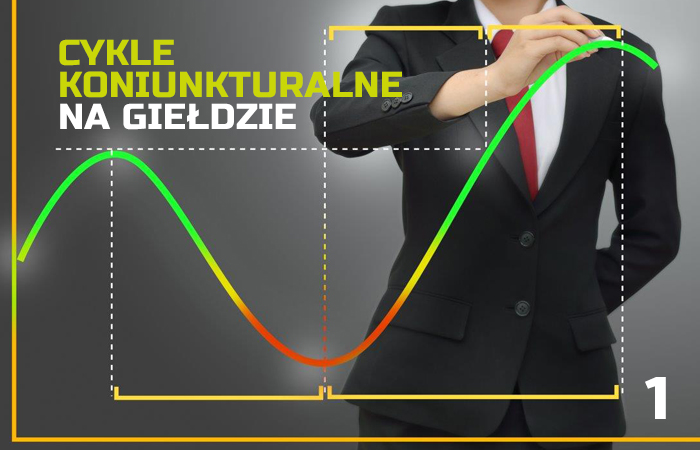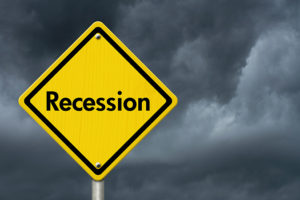Business cycles on the stock market, part AND
We already know the concept bullish and bearish financial markets. It is largely related to the cycles (business cycles, market phases) that occur in them. They can be easily compared to the seasons, in which each is characterized by specific and specific features. It is much the same with business cycles. Not only do they facilitate portfolio diversification in terms of having the most profitable assets, but also provide the basic knowledge that every investor should have. In this article, we will look at more than just the cycles. We will discuss the links that exist between them, the possible risks and the ways by which we will recognize them.
What are business cycles?
Business cycles, as mentioned above, are based on a certain "phase" of the market. They appear at intervals of several years (it is assumed that they usually last about 5 years). However, this period is highly contractual, due to the mass of factors that affect it. The current changes (including technological ones) that are taking place in the broadly understood economy are revolutionary. Consequently, there is no rigid and exact duration for each of them.
There are four main phases that the market enters during the entire cycle. Belong to them slowdown, recession, recovery and expansion. They differ mainly in the direction of changes and the values of the main economic indicators. Thanks to them, we can in some way forecast and estimate the probability of entering particular phases. Economic indicators that will interest us include, among others CBA and the level of inflation. Sometimes the unemployment rate can also be taken into account in the context of "supporting" data. Nevertheless, it works more well in the American than European markets, which does not mean that it cannot be influenced by the employment data as well. Publications on the wealth of the society or investment outlays may also prove useful.
READ NECESSARY: Market barometer, or a few words about indices
In one of the texts published on the portal, we discussed stock market indices that reflect the economic situation of companies listed on the stock exchange. Therefore, you can safely use the data that is a kind of barometer. On them, we can easily spot trends and tendencies to reverse them, without knowing the detailed rules of technical analysis. We can see them with the naked eye. Here, however, it is important to take a larger time frame than a few months for the analysis.
GDP and inflation
It is not without reason that central banks closely monitor the inflation rate (among others) and set themselves targets that it should achieve and levels that it should not exceed. The increase in prices and the study of its dynamics is so important that in the event of too high (annual or quarterly) changes, banks may intervene in the matter of e.g. interest rates. This factor is crucial primarily for the bond market. The supply of money in the economy is shaped to a large extent by steering the interest rate policy. This is related to, for example, a decrease or increase in interest on loans, which affects the financial results and profitability of companies.
Generally speaking, observing the activities of central banks (knowing the relationships between the phases and GDP and inflation, and the influence of interest rates on both indicators) can be quite easily determined what phase we are in. We do not have to analyze macroeconomic data ourselves from scratch. The activities, reports, meetings and comments of these institutions often shed a clear light on where we are now in the cycle. Therefore, observing the fiscal and monetary policy of the central bank gives us a large dose of information on the current phase in which the markets operate.
The level of GDP in a given country shows us the pace of economic development. Thanks to this index, we are able to determine the general economic situation of a particular country, comparing it, for example, to the results from previous years. Both measures (GDP and inflation) are good indicators of changes taking place in the market situation. Below, in each phase described by us, you will find information on how they behave and what trends (dynamics of change) we should expect from the transition from one phase to the other.
Slowing down
It takes place immediately after the expansion phase. The economy of the country works very intensively. Therefore, the economic growth rate will be at a very high level and, necessarily, its earlier readings will show dynamics and an upward trend. Due to the warm and strong economic situation, the unemployment rate is low. What does it mean low? It oscillates around a few percent, which in many economics textbooks is called the concept of natural unemployment. In practice, it means that everyone capable of performing professional activity can get a job.
READ ALSO: The economic situation is a circle - about the cyclical nature of the economy
At the end of the expansion phase, the production capacity of the economy is situated at a very high level. Full production capacity and high employment contribute to higher prices, and thus inflation. Of course, this situation is constantly monitored by the central bank. All its changes in market issues, of course, act with a certain delay. At the peak of economic expansion, when the inflation level begins to rise, the bank slowly raises interest rates. Why is he doing this? This is to reduce the flow of money that flows into the economy. Of course, higher interest rates mean more expensive credit. More difficult and more expensive external financing causes, among other things, that consumers are reluctant to look at spreading payments into installments, e.g. for luxury goods (cars, real estate, etc.).
Only cash?
Given that the economy lags behind interest rate increases, the boom comes with high economic growth rates and high interest rates. So the question arises, what is happening to the inflation rate? In fact, it will continue to grow for some time, but nevertheless its dynamics will be lower and lower, until the tendency is completely reversed. High interest rates will encourage some citizens to limit their consumption and save money. The slowdown phase is not the best time to invest in stocks.
If we are an investor in style Warren Buffett, of course, we keep them throughout the downturn and recession, possibly also accumulating them at a good price. If, on the other hand, our strategy focuses solely on reaping profits from stocks in the recovery and expansion phase, it is best to allocate funds to cash deposits. High interest rates will favor savers and cash holders. Another way to protect your money is to put your funds in floating-rate bonds.
Without a doubt each economy has its own rules. Therefore, the length of the slowdown phase and its course may differ from the theoretical assumptions. Sometimes the policy of central banks is not as intense as that of others and extends over time. Therefore, the economy not only experiences any changes with a delay, but also the additional, free policy of banks in terms of interest rates, the slowdown will "stretch" significantly. It is therefore worth following not only the actions of central banks, but also their direct impact on the main macroeconomic indicators in the perspective of at least a few quarters.
In the next section of this article, we will discuss the phases of recession, recovery and expansion. We invite you to read on.






















![Forex Club – Tax 9 – Settle tax on a foreign broker [Download the Application] Forex Club - Tax 9](https://forexclub.pl/wp-content/uploads/2024/02/Forex-Club-Podatek-9-184x120.jpg?v=1709046278)
![Trading View platform – solutions tailored to the needs of traders [Review] trading view review](https://forexclub.pl/wp-content/uploads/2024/03/trading-view-recenzja-184x120.jpg?v=1709558918)
![How to connect your FP Markets account to the Trading View platform [Guide] fp markets trading view](https://forexclub.pl/wp-content/uploads/2024/02/fp-markets-trading-view-184x120.jpg?v=1708677291)
![How to invest in ChatGPT and AI? Stocks and ETFs [Guide] how to invest in chatgpt and artificial intelligence](https://forexclub.pl/wp-content/uploads/2023/02/jak-inwestowac-w-chatgpt-i-sztuczna-inteligencje-184x120.jpg?v=1676364263)


![WeWork – the anatomy of the collapse of a company valued at $47 billion [WeWork, part II] wework bankruptcy story](https://forexclub.pl/wp-content/uploads/2024/04/wework-bankructwo-historia-184x120.jpg?v=1711729561)
![Adam Neumann – the man who screwed up Softbank [WeWork, part AND] adam neumann wework](https://forexclub.pl/wp-content/uploads/2024/04/adam-neumann-wework-184x120.jpg?v=1711728724)





![How to transfer shares to another brokerage office [Procedure description] how to transfer shares to another brokerage house](https://forexclub.pl/wp-content/uploads/2024/03/jak-przeniesc-akcje-do-innego-biura-maklerskiego-184x120.jpg?v=1709556924)

![The most common mistakes of a beginner trader - Mr Yogi [VIDEO] Scalping - The most common mistakes of a beginner trader - VIDEO](https://forexclub.pl/wp-content/uploads/2024/03/Scalping-Najczestsze-bledy-poczatkujacego-tradera-VIDEO-184x120.jpg?v=1711601376)
![Learning patience: No position is also a position - Mr Yogi [VIDEO] Scalping - Learning patience - No position is also a position - VIDEO](https://forexclub.pl/wp-content/uploads/2024/03/Scalping-Nauka-cierpliwosci-Brak-pozycji-to-tez-pozycja-VIDEO-184x120.jpg?v=1710999249)
![When to exit a position and how to minimize losses - Mr Yogi [VIDEO] Scalping - When to exit a position and how to minimize losses - VIDEO](https://forexclub.pl/wp-content/uploads/2024/03/Scalping-Kiedy-wyjsc-z-pozycji-i-jak-minimalizowac-straty-VIDEO-184x120.jpg?v=1710336731)

















